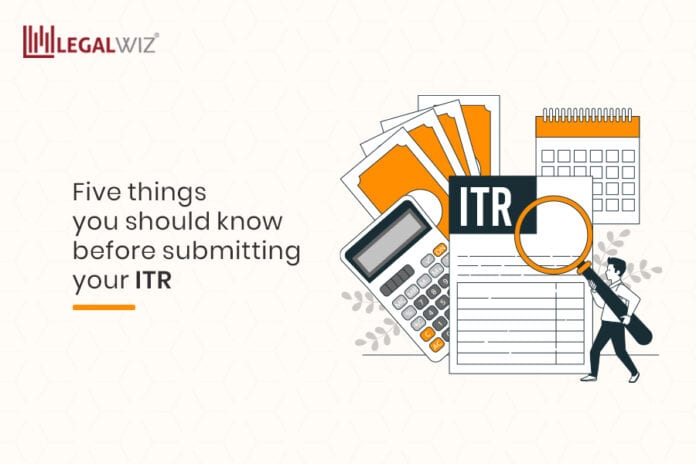It is that time of the year when you submit your income tax return. You can always seek professional help to do so, but if you are intending to do it yourself, then there are few things that you should heed.
Here are the five things that you should know about before filing your income tax return.
Change in the Income-tax return forms.
To make the process of Income Tax return filing simple, the CBDT (central board of direct taxes) has made some amendments to the forms. For the current AY (assessment year), there are 7 ITR forms, earlier there used to 9 of which three ITR forms have been rationalized (ITR-2, ITR-2A, ITR-3), and a single -2 has replaced them. Likewise, ITR-4 and ITR-5 (Sugam) have been renumbered as ITR-3 and ITR-4 (Sugam).
The new ITR-1 (Sahaj) is a one-page form and it can be submitted only by a person with taxable income of up to Rs. 50 lacs per annum. The income could be salary, one house property or interest. And those who have an income of more than Rs. Fifty lacs or possess more than one house property are obliged to submit ITR-2 form.
Besides, several parts of the ITR-1 (Sahaj) form concerning deduction and tax computation have been rationalised. Thus, only deductions stated are sections, as only sections 80C, 80D, 80G, and 80TTA and so forth. The rest must be noted in the other box, says Suraj Nangia, partner of the Nangia and Co. LLP.
Quoting Aadhar.
The finance act, 2017, made it compulsory to quote Aadhar to submit an ITR, w.e.f. 1st of July, 2017. It was later challenged in the supreme court, where the court permitted it and ruled you are obliged to mention a 12-digit Aadhar number or 28-digit Aadhar enrolment number while submitting the ITR. Before that, Aadhar number while submitting ITR was optional, says the Nangia.
To link one’s Aadhar with their PAN, one will have to go to the official website of ITR and click on the link Aadhar. Then one will have to provide PAN and Aadhar number, and in the one’s name in the ‘name’ column as given in the Aadhar and submit. Once the UIDAI does the verification, the linking will be confirmed.
New sections in the income tax return forms.
The dividend income was precedingly exempt from tax in the hands of the assessee, regardless of the amount of dividend received. But not dividend income of more than Rs. Ten lacs would be taxable at the rate of 10% and it is needed to be reported in the schedule updates. Besides, income received by an individual in the form of royalty for the patents registered and developed in the country will be taxable at the rate of 10%. Also, it would be reported under the schedule OS.
In the finance act, 2013, the new deduction under section 80EE was brought into place, which remained available for two years FY-2013-15. Under which, the first-time homebuyer was permitted to claim a deduction of up to Rs. one lac (for each year) against interest paid on home loans. It would, in addition to deduction available under section 24(b) of Rs. Two lacs. Section 80EE has been restated for the AY-2017-18. Nonetheless, this time the deduction limit is up to Rs. Fifty thousand per annum, initiating from FY-2016-17 and for upcoming years until the loan is repaid. The deduction is permitted only if the value of a house is not more than Rs. Fifty lacs with a home loan of not more than Rs. Thirty-three lacs and loans are authorised in FY-2017.
To claim this, a new column for this deduction has been put in place in the ITR form under the schedule VI-A. The first-time homebuyer now gets an annual deduction of Rs. 2.5 lacs on interest paid.
Compulsory disclosures.
To account for those who have deposited Rs. Two lacs or more than that in the bank account in the demonetisation time, the tax department has put in place a new column where an individual submitting tax would have to provide details in the ITR of the money deposited as well as bank account’s details such as the name of the bank, account number, and IFSC code.
Also, suppose any assessee has any unknown income or investment. In that case, he/she has to report such undisclosed income in the new ITR forms, and the amount will be taxable at the tax rate of 60% along with cess and surcharge.
Other information.
In the finance act, 2016, a new schedule was brought into place that required individuals and HUFs whose income is more than Rs. Fifty lacs per annum to declare the value of their assets and liabilities. Such information like cost of immovable property, jewellery, bank and cash balance, vehicles and so forth. Now the taxpayers are also obliged to reveal the address of immovable property and explanation of movable property which is why it is crucial to follow tax saving tips. Also, the time for revision of ITR has been cut to one year from two years.
Hence, if you are intending to submit your tax return, you must ensure that you are familiar with all the new changes.
Help keep news FREE for our readers
Supporting your local community newspaper/online news outlet is crucial now more than ever. If you believe in independent journalism, then consider making a valuable contribution by making a one-time or monthly donation. We operate in rural areas where providing unbiased news can be challenging. Read More About Supporting The West Wales Chronicle
























